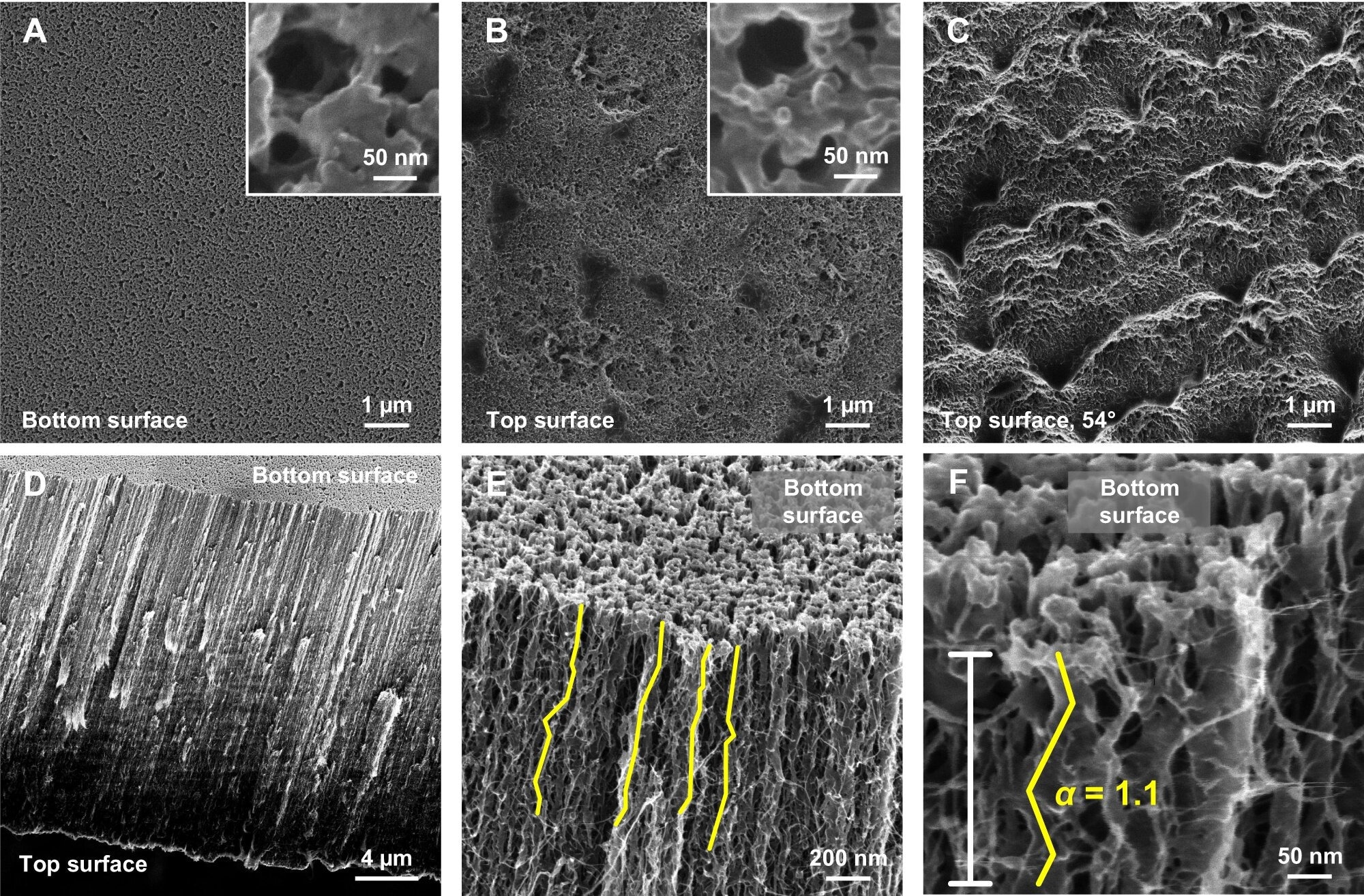Vertically aligned carbon nanotube (VaCNT) membranes can be used to clean or desalinate water with a high flow rate and low pressure. Recently, researchers from the Karlsruhe Institute of Technology (KIT) and collaborators conducted steroid hormone adsorption experiments to investigate the interaction of forces in microscopic pores.
 Surface and pore morphology of VaCNT membranes. A, B Top and bottom surface of the VaCNT membrane (the insets resolve the membrane 'pores' on both surfaces). C View of the top surface at a tilt angle of 54° showing the roughness of this surface. D, E, F Increasing zooms of the VaCNT membrane cross-section at a tilt angle of 54°. The possible flow paths highlighted in E and F gives an estimate of the pore tortuosity. Image Credit: Nature Communications (2024). DOI: 10.1038/s41467-024-44883-2
Surface and pore morphology of VaCNT membranes. A, B Top and bottom surface of the VaCNT membrane (the insets resolve the membrane 'pores' on both surfaces). C View of the top surface at a tilt angle of 54° showing the roughness of this surface. D, E, F Increasing zooms of the VaCNT membrane cross-section at a tilt angle of 54°. The possible flow paths highlighted in E and F gives an estimate of the pore tortuosity. Image Credit: Nature Communications (2024). DOI: 10.1038/s41467-024-44883-2
They discovered that VaCNTs with certain pore geometry and surface structure are suitable for usage as highly selective membranes. The study was published in Nature Communications.
Everyone on the planet requires access to safe drinking water. Membranes are utilized to efficiently remove micropollutants, such as steroid hormones, which are hazardous to human health and the environment. A highly prospective membrane material is built of vertically aligned carbon nanotubes (VaCNT).
This material is amazing—with small pores of 1.7 to 3.3 nanometers in diameter, a nearly perfect cylindrical shape, and small torsion. The nanotubes should have a highly adsorbing effect, but have a very low friction only.
Andrea Iris Schäfer, Professor, Institute for Advanced Membrane Technology, Karlsruhe Institute of Technology
Pores are currently too large for efficient retention, yet smaller pores are not technically practical.
Interplay of Forces
In studies using steroid micropollutants, IAMT researchers investigated why VaCNT membranes make excellent water filters. They utilized membranes made by the Lawrence Livermore National Laboratory (LLNL) in Livermore, California. The finding: VaCNT's low adsorption, or surface deposition, is useful for highly selective membranes that target specific molecules.
The study demonstrates that adsorption in membrane nanopores is dependent not only on the adsorption surface and limited mass transfer, but also on the interaction of hydrodynamic forces, friction, and attraction and repulsion forces at the liquid-wall interface. Due to their low friction and rapid flow velocity, highly water-permeable nanopores have little contact.
Schäfer added, “When the molecules are not retained because of their size, interaction with the material will often determine what happens. The molecules will bounce through the membrane similar to a climber climbing a wall. This is much easier when there are many good climbing holds.”
Pore geometry and surface structure are specially designed with the help of studies such as the one carried out by IAMT.
Ten Years to Turn the Idea into an Experiment
At LLNL, Dr. Francesco Fornasiero and his colleagues created the membranes. The most recent analytical equipment at IAMT was used to conduct and assess the micropollutant tests.
“It took about 10 years to turn the idea into a successful experiment that has met with the wide interest of the membrane technology community,” Schäfer added.
It is quite challenging to produce membranes that are so nearly flawless. In larger regions up to a few square centimeters, there is a very high likelihood of defects. And defects would affect the outcome. LLNL has been successful in creating membranes in larger regions in recent years. To keep trace contaminants on two square centimeters for studies, IAMT researchers concurrently constructed minuscule filtration devices.
“Downscaling is extremely difficult. Having managed this together is a big success. Now, we are waiting for the development of membranes with even smaller pores,” Schäfer further added.
The research was the first to look at how hydrodynamic forces, friction, and attraction and repulsion interacted. It presents fundamental results on water handling. These might help ultra- and nanofiltration processes controlled by nanopores.
Journal Reference:
Nguyen, M. N., et. al. (2024) Interplay of the forces governing steroid hormone micropollutant adsorption in vertically-aligned carbon nanotube membrane nanopores. Nature Communications. doi:10.1038/s41467-024-44883-2.